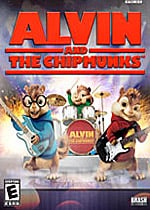Jam with the Chipmunks
Alright, before this review goes any farther, Alvin and the Chipmunks is a game for very small children. I don’t think anyone over the age of ten would even remotely enjoy this game. In fact, they would hate it. But this game is not for them. They’ve got Gears and Halo. Alvin and the Chipmunks is a game for the little ones, and as such should be given a little leeway in terms of play mechanics, value, and difficulty. Of course, it can’t be given all the credit in the world just because it’s a kid’s game, but I just wanted to say up front that this is a review with some perspective.
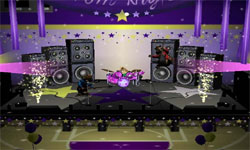
But now that we have the niceties out of the way, let’s get down to brass tax. Is this a good game? Well, it depends on what you’re little one is looking for. Alvin and the Chipmunks is essentially a rhythm-based game that has you button mashing to the beat. The game has four main modes: story mode, quick play, two-player, and video mode. The first mode that you’ll have to tackle is story mode, as this mode unlocks all the other modes. In story mode, you’ll follow the exploits of Alvin, Simon, and Theodore as they try to make it to Rockathonapalooza, which is apparently the hottest rock show in town. You’ll have to play through a number of venues, each one getting larger as you go on. So naturally, you start off in a dream sequence, and then go on to play at the prom, the mall, and a number of other small gigs until you finally hit the big time.
When playing through the story mode, you’ll have to play (and pass) through three songs to get to the next venue. The way you play the game is a little bit different then the other rhythm games you may have encountered. Essentially, little star icons come from the center of the screen and will float to one of four color-coordinated corners. Depending on which corner the stars float to, there will be a corresponding button that you’ll have to hit to activate the note. The closer you get to activating the note while it is on top of its destined corner, the more points you’ll get. Activate the note right in the center, and you’ll receive a “perfect” ranking for the note, which comes with buku points. Hit ten or more perfect notes, and you’ll activate a multiplier bonus. For every ten perfect notes you get, you’ll get another multiplier thrown on. After you finish a song, you’ll be graded on a star scale from zero to three stars.
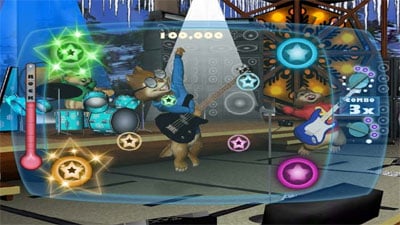
After you unlock all the songs in story mode, you can explore the other modes in the game. The first mode is quick play, which essentially lets the player quickly go back and play any song they’ve unlocked without having to remember which venue they unlocked it in during story mode. Quick play mode also gives players the chance to improve their individual high score on a song. The next mode is the two-player mode. This mode essentially lets two people play through a song unlocked in story mode via a horizontal split-screen. This mode can also be fun for families to play together because each player can select their own difficulty mode. Another good thing about the two-player mode is that it doesn’t declare a “winner” or “loser; it only compares the two scores at the end. The final mode is the video mode, which isn’t necessarily a mode of play, but instead a playback of the background graphics during a song with the chipmunk song played over it. This mode is pretty good if the little gamer in your family just wants to listen to some chipmunk-style tunes and do some grooving in the living room.
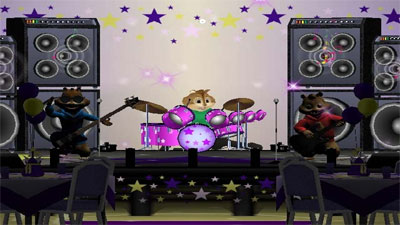
As far as those tunes go, there’s one thing you can say for sure: these songs are rendered faithfully in chipmunk style. Whether or not that is a good or bad thing, I’ll leave to you. But the songs definitely sound a lot like their original counterparts with some high-pitched vocals to give them the signature chipmunk effect. Some of the song highlights from this title include “Heartbreak Hotel” originally by Elvis Presley, “Love Shack” originally by the B52’s, and, oddly enough “Santa Monica” originally performed by Everclear. Not sure if the little ones will appreciate the full meaning of that one, but I suppose good music is good music, right?
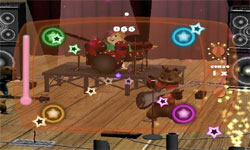
Graphics-wise, this game is really not that much to look at. Honestly, the graphics are GameCube-era or early PlayStation 2 at best. Scenes that involve plot elements are just still photographs with voiceovers, and the whole thing just doesn’t look good. However, because this game is aimed at the younger sect, I’m not too sure how hung up the little kids are going to be with the graphics. The real centerpiece of this game for the little ones will probably be the songs, and more than likely they won’t even notice whether the graphics are good or not.
Overall, Alvin and the Chipmunks is a pretty good game for young kids. It will introduce them to the great fun that is the rhythm genre. And even though the game might seem boring, repetitive or stupid to those of us in the older generation, the younger sect will appreciate the simplistic gameplay and the fun chipmunk-y songs. I would fully recommend this game to people who know a little one who loves music, and is just starting to get into the world of video gaming.
Features:
RATING OUT OF 5 RATING DESCRIPTION 1.5 Graphics
Looks like a GameCube game, and “cinema” scenes are no more than stills with dialogue. 3.5 Control
Very simplistic, but at least they’re responsive, if not repetitive. 3.0 Music / Sound FX / Voice Acting
Faithful Chipmunk renditions of some pretty classic songs. If that’s good or bad, I’ll leave for you to decide. 3.0 Play Value
The eight and under crowd will love playing this one after school or before bedtime. Anyone else should have known better. This is obviously for the younger sect. 2.8 Overall Rating – Average
Not an average. See Rating legend above for a final score breakdown.
